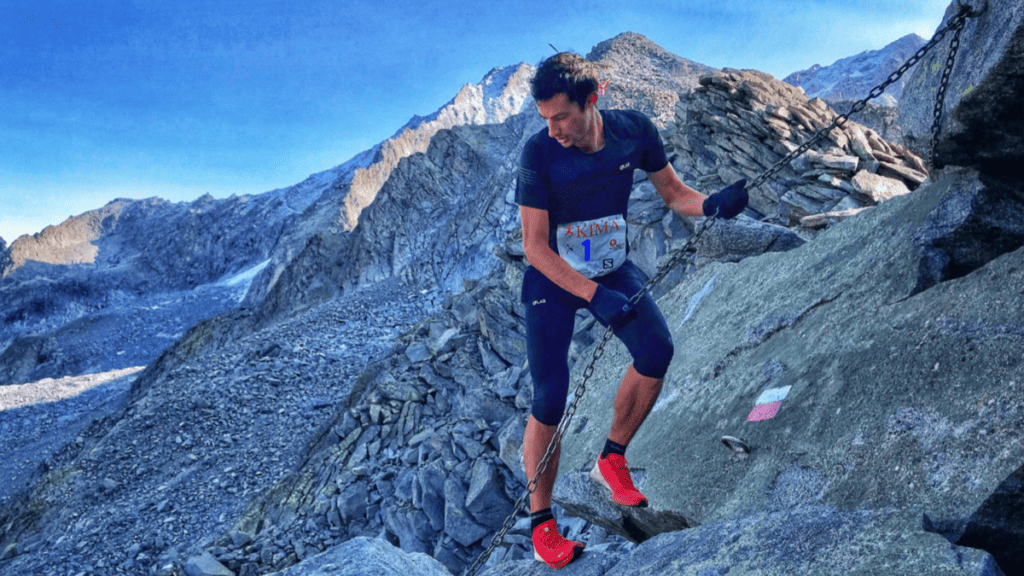
The topic that we are looking at today is actually one that I need to take to heart more. I am notorious for overestimating my skills and even more so, my fitness. As a result, I often take on events and adventures that are so beyond my comfort zone that they might as well be in another dimension altogether.
Begin by assessing both your skill level and fitness level. Sky running along a knife-edge ridge will not work if you’re afraid of heights. If your longest run is 10km, choose shorter events and build up gradually. Being truthful about your skills and fitness will allow you to enjoy the event.
Let’s take a closer look at all of the factors that you need to look at so that you can not only match your next event to where your skill and fitness level currently is but also plan out a series of events that will get progressively more challenging without completely breaking you.
Understanding Your Trail Running Skill Level
Reflecting on your current trail running abilities and experiences is an important first step in understanding your trail running skill level. Take some time to think about the types of terrains and distances you have successfully navigated in the past. This will help you gauge your comfort level and determine the appropriate level of challenge for your next trail running event.
Consider the different terrains you have encountered, such as rocky trails, steep inclines, or technical singletrack. Think about how you handled these terrains and whether you felt confident and in control. This will give you an idea of the level of difficulty you are comfortable with and whether you are ready to tackle more challenging trails.
In addition to terrains, think about the distances you have covered in your trail running adventures. Have you completed shorter distances like 5K or 10K races, or have you pushed yourself to complete longer distances like half marathons or even ultra-marathons? Understanding your endurance and stamina will help you choose an event that aligns with your current fitness level.
By reflecting on your past experiences, you can gain a better understanding of your trail running skill level. This self-assessment will serve as a foundation for selecting the right trail running event that will challenge you without overwhelming you. So take the time to evaluate your abilities and set yourself up for success in your next trail running endeavor.
Researching Trail Running Events
When it comes to finding the right trail running event for your skill level, conducting thorough research is essential. There are several criteria you should consider during your research to ensure you choose an event that aligns with your abilities and goals.
One important aspect to consider is the distance of the event. Whether you’re a beginner or an experienced trail runner, it’s crucial to select a distance that challenges you without pushing you beyond your limits. Look for events that offer a variety of distances, such as 5K, 10K, half marathons, or even ultra-marathons, so you can choose the one that suits your current fitness level.
Another factor to consider is the terrain and difficulty level of the trails. Some runners may prefer technical singletrack with steep inclines, while others may enjoy smoother, less challenging terrains. Evaluate your comfort level with different terrains and choose an event that matches your preferences and skill level.
Additionally, researching the reputation and organization of the event is important. Look for reviews and feedback from previous participants to get an idea of the event’s quality and organization. Consider factors such as course markings, aid stations, and overall participant experience to ensure a well-organized and enjoyable event.
Lastly, explore online platforms, local running clubs, and event organizers to discover upcoming trail running events. These resources can provide valuable information about event dates, registration fees, and any additional amenities or support offered.
By considering these criteria during your research, you can find the perfect trail running event that challenges you, aligns with your skill level, and provides an enjoyable experience. So take the time to explore your options and make an informed decision for your next trail running adventure.
Assessing Trail Difficulty and Terrain
When choosing a trail running event, it’s crucial to assess the difficulty level and terrain to ensure it aligns with your skill level and preferences. Factors such as elevation gain, technicality, and altitude can significantly impact your choice of an event.
Elevation gain refers to the total vertical distance you will ascend during the race. Events with higher elevation gain can be more challenging, requiring greater endurance and strength. If you’re a beginner or prefer less strenuous races, consider events with lower elevation gain to start with.

Technicality refers to the level of difficulty of the trail itself. Some trails may have steep inclines, rocky sections, or narrow paths, requiring advanced running skills and agility. Evaluate your comfort level with technical trails and choose an event that matches your abilities. Beginners may opt for smoother, less technical trails, while experienced runners may seek more challenging routes.
Altitude is another crucial factor to consider, especially if you’re not accustomed to running at higher elevations. Higher altitudes can affect your breathing and performance, making it more challenging to maintain your pace. If you’re not acclimated to high altitudes, it’s advisable to choose events at lower elevations or give yourself ample time to adjust before the race.
By evaluating these factors, you can select a trail running event that suits your skill level and preferences. Consider your comfort level with elevation gain, technicality, and altitude to ensure an enjoyable and fulfilling experience. Remember, it’s important to challenge yourself, but also to choose an event that you feel confident and comfortable participating in.
Setting Realistic Goals
When it comes to trail running, setting realistic goals based on your current skill level is essential for a more enjoyable and fulfilling experience. By defining your goals, you can tailor your training and choose events that align with your capabilities.
One important aspect of setting realistic goals is considering your fitness level. Assess your endurance, speed, and strength to determine what you can realistically achieve. Setting goals that are too ambitious can lead to frustration and disappointment, while setting goals that are too easy may not provide the challenge you desire.
Another factor to consider is your experience with trail running. If you’re a beginner, it’s important to start with smaller, less technical events to build your confidence and skills. As you gain more experience, you can gradually increase the difficulty level and distance of the events you participate in.
Setting goals that are specific and measurable is also crucial. Instead of simply aiming to “finish a race,” consider setting goals such as improving your race time or completing a certain distance within a specific timeframe. These goals provide a clear target to work towards and allow you to track your progress.
By setting realistic goals, you can ensure that you’re pushing yourself to improve while still enjoying the process. Remember to be flexible and adjust your goals as needed, taking into account any changes in your fitness level or circumstances. Ultimately, setting realistic goals will contribute to a more satisfying and rewarding trail running experience.
Considering Event Distances
When choosing a trail running event, it’s important to consider the various distances offered and select one that aligns with your capabilities. The distance of an event can greatly impact the level of challenge and the amount of training required.
One factor to take into account is your current fitness level. If you’re new to trail running or have limited experience, it may be wise to start with shorter distances, such as 5K or 10K races. These distances are more manageable for beginners and allow you to gradually build your endurance and confidence.
On the other hand, if you’re an experienced trail runner looking for a greater challenge, longer distances like half marathons, marathons, or even ultra-marathons may be more suitable. These events require a higher level of fitness and training, as they often involve more technical terrain and longer periods of running.
Another factor to consider is the amount of time you can dedicate to training. Longer distances generally require more training hours per week to adequately prepare. If you have limited time available, it may be more realistic to choose a shorter-distance event that fits within your schedule.
Lastly, consider your personal goals and preferences. Are you looking to set a personal record, challenge yourself, or simply enjoy the experience? Different distances offer different levels of difficulty and require varying strategies. Choose a distance that aligns with your goals and allows you to fully enjoy the event.
By considering your fitness level, training availability, goals, and preferences, you can choose an event distance that is both challenging and achievable for you. Remember to listen to your body and gradually progress to longer distances as you gain experience and confidence in your trail running abilities.
Examining Race Formats
Race formats play a significant role in the overall experience of a trail running event. Different formats, such as point-to-point races, loops, and ultras, can greatly influence the difficulty and strategy of the event.
Point-to-point races involve starting at one location and finishing at another. These races often offer a sense of adventure and exploration as runners traverse different terrains and landscapes. The distance covered can vary, ranging from shorter distances to longer ultra-marathons. Point-to-point races require careful planning and logistics, as participants need to arrange transportation to the starting line and from the finish line.

Loop races, on the other hand, involve running multiple laps of a designated course. This format allows runners to become familiar with the terrain and adjust their strategy accordingly. Loop races can be mentally challenging, as participants may need to push through fatigue and monotony. However, they also offer the advantage of having aid stations and support available at regular intervals.
Ultra races are known for their extreme distances, typically exceeding the marathon distance of 26.2 miles. These races require a high level of endurance, mental fortitude, and strategic planning. Ultra races often take place on challenging terrain, such as mountains or trails with significant elevation gain. Participants must carefully pace themselves and manage their nutrition and hydration to ensure they can complete the race.
The race format you choose should align with your skill level, goals, and preferences. Point-to-point races offer a sense of adventure and exploration, while loop races provide familiarity and support. Ultra races are reserved for experienced trail runners seeking a significant challenge. Consider the format that best suits your abilities and desired experience when selecting a trail running event.
Reviewing Event Amenities and Support
When choosing a trail running event, it is crucial to consider the amenities and support provided by event organizers. These factors can greatly impact your overall experience and ensure a safe and enjoyable race.
One important aspect to investigate is the availability of aid stations along the course. Aid stations provide runners with water, electrolyte drinks, and snacks to fuel their performance. They also offer medical assistance if needed. Having well-stocked aid stations at regular intervals can make a significant difference, especially during longer races or in challenging weather conditions.
Another crucial consideration is the level of medical support provided by the event organizers. Trail running can be physically demanding, and injuries or accidents can occur. Knowing that there are medical professionals on-site or nearby can provide peace of mind and ensure prompt assistance if necessary.
Race logistics are also an important factor to review. This includes information about parking, transportation to and from the event, and any necessary permits or waivers. Understanding the logistics beforehand can help you plan your race day effectively and avoid any last-minute surprises or stress.
By thoroughly reviewing the event amenities and support, you can make an informed decision that aligns with your needs and preferences. Prioritizing races that offer well-stocked aid stations, reliable medical support, and clear logistics will contribute to a positive and successful trail running experience.
Consulting with Experienced Trail Runners
Consulting with experienced trail runners can provide valuable insights and tips to help you choose a trail running event that matches your skill level. Seasoned trail runners have firsthand knowledge and experience that can guide you in making an informed decision.
One important aspect to consider is the difficulty level of the trail. Experienced trail runners can provide information about the technicality of the terrain, elevation changes, and any potential hazards to be aware of. Their advice can help you gauge whether a particular event is suitable for your current skill level or if it may be too challenging.
Experienced trail runners can also offer recommendations on specific events that cater to different skill levels. They may suggest races that are known for their beginner-friendly courses or races that offer more advanced challenges for experienced runners. Their recommendations can help you narrow down your options and find events that align with your goals and abilities.
Additionally, seasoned trail runners can provide insights into the overall atmosphere and vibe of different events. They can share their experiences with race organizations, the camaraderie among participants, and the overall enjoyment factor. This information can help you choose an event that not only matches your skill level but also provides a positive and enjoyable experience.
By seeking advice from experienced trail runners, you can tap into their knowledge and expertise to make an informed decision when choosing a trail running event. Their insights and tips can help you find the right event that challenges you appropriately and allows you to fully enjoy the experience.
Considering Seasonal and Environmental Factors
When choosing a trail running event, it’s important to take into account the seasonal and environmental conditions of the event location. Factors such as weather, temperature, and time of year can significantly impact your trail running experience.
Firstly, consider the weather conditions. Is the event taking place during a rainy season or in an area prone to extreme weather? Running in wet and muddy conditions can make the trail more challenging and increase the risk of slips and falls. On the other hand, running in hot and humid weather can be physically demanding and may require additional hydration and cooling strategies. By understanding the weather patterns of the event location, you can better prepare yourself and choose an event that aligns with your preferences and comfort level.
Secondly, take into account the temperature. Running in extreme heat or cold can have a significant impact on your performance and overall enjoyment. High temperatures can lead to dehydration and heat exhaustion while freezing temperatures can increase the risk of hypothermia. Consider your tolerance for different temperature ranges and choose an event that falls within your comfort zone.
Lastly, consider the time of year. Some trail running events take place during peak seasons when the trails are at their best condition, while others may be scheduled during off-peak times when the trails are less maintained. Additionally, certain times of the year may coincide with beautiful scenery or natural phenomena, adding to the overall experience of the event.
By considering the seasonal and environmental factors of the event location, you can make an informed decision and choose a trail running event that offers optimal conditions for your skill level and preferences. Remember to plan accordingly and come prepared with the necessary gear and knowledge to ensure a safe and enjoyable trail running experience.
Balancing Challenge and Enjoyment
When choosing a trail running event, it’s important to strike a balance between challenging yourself and ensuring an enjoyable experience. Finding an event that pushes your limits without overwhelming you can be a rewarding and fulfilling experience.
One way to achieve this balance is by researching the difficulty level of the trail and terrain. Look for events that offer a variety of difficulty options, ranging from beginner-friendly trails to more advanced and technical routes. This allows you to choose a trail that matches your skill level and comfort zone, while still providing a challenge that pushes you to improve.
Another factor to consider is the distance of the event. If you’re new to trail running or prefer shorter distances, look for events that offer shorter race options or have a variety of distances to choose from. This allows you to challenge yourself without committing to a longer, more demanding race that may be overwhelming.
Additionally, consider the race format of the event. Some events offer timed races, while others focus on the overall experience and camaraderie of the trail running community. Choose a race format that aligns with your preferences and goals, whether it’s competing against the clock or enjoying the journey with fellow runners.
Lastly, don’t forget to review the event amenities and support. Look for events that provide aid stations, medical support, and well-marked trails. Having these amenities in place can enhance your overall experience and provide peace of mind, allowing you to focus on the challenge of the race.
By finding a trail running event that strikes a balance between challenge and enjoyment, you can push your limits, improve your skills, and have a memorable experience on the trails. Remember to listen to your body, set realistic goals, and enjoy the journey as you conquer new challenges.
